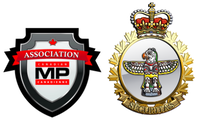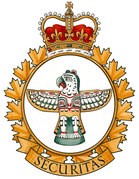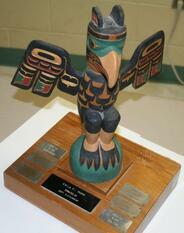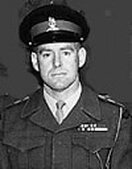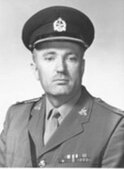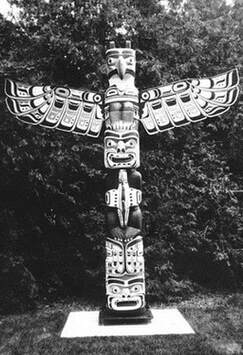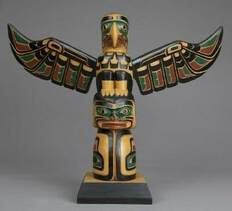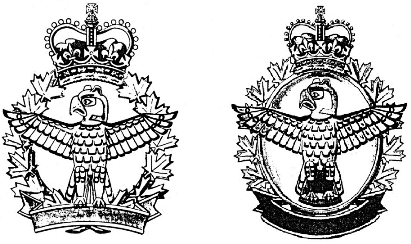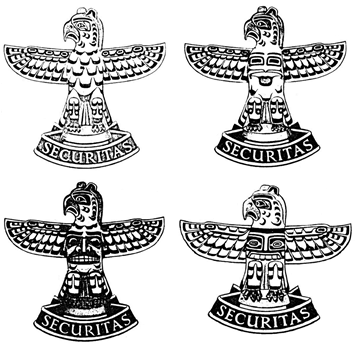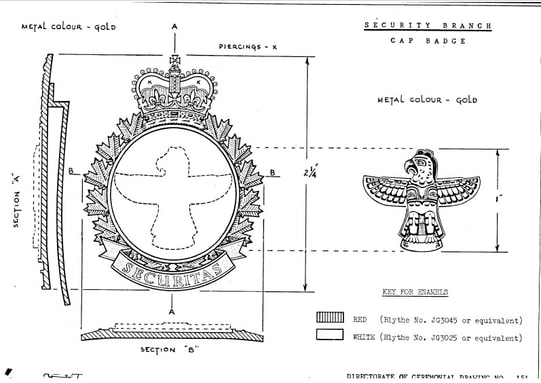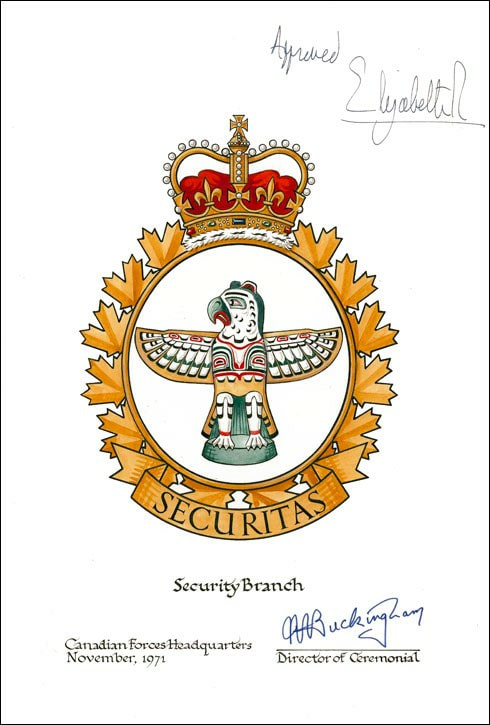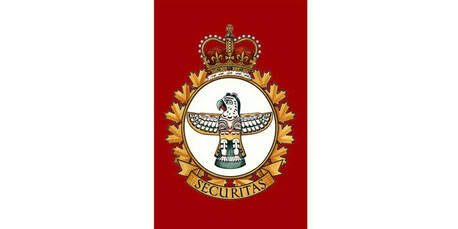Looking Back: The Thunderbird Badge
By Lieutenant-Colonel Paul Thobo-Carlsen (Retired), CMPA Director of History & Heritage.
|
The Thunderbird, in the Northwest Pacific Coast First Nations style, has been the primary symbol the Military Police of the Canadian Armed Forces for almost half a century. The Thunderbird badge was first adopted by the Security Branch, the predecessor of the current Military Police Branch, in the early 1970’s.
On 15 May 1967, following the initial integration of Canada’s Army, Navy and Air Force —and with their full unification into a single military service looming on the horizon — the newly appointed Director General of Intelligence and Security (DGIS, Brigadier General L.E. Kenyon) ordered the formation of an Insignia Steering Group (ISG) to make recommendations on an appropriate identifier for the new Security Branch.[1, 2] The creation of the ISG recognized the need to replace all corps and service badges used by the various military policing and intelligence entities up to that point.
|
Security Branch badge – 1972 to 1999
Military Police Branch badge – 2000 to present |
The Insignia Steering Group was chaired by Major William P. Stoker (Canadian Provost Corps) and its members were Major David W. Wiens (Canadian Intelligence Corps), Flight Lieutenant D.J. Currie (Royal Canadian Air Force) and Lieutenant G.E Van Sickle (Royal Canadian Navy). After studying many submitted proposals, the ISG recommended the totemic Thunderbird as the unifying symbol for the Security Branch. Maj Stoker, who personally briefed the dozen or so submitted proposals to BGen Kenyon and his insignia selection committee, later stated that the Thunderbird concept was a “slam dunk” since it was the only submission that fully met DGIS’ criteria that the new badge must not incorporate any symbols used by previous military police or intelligence organizations.[3]
|
CMIA Photo Interpretation Trophy. Photo: Canadian Forces School of Military Intelligence
|
In a letter to the editor printed in Spring 1969 edition of SECURITAS (the Security Branch journal), then Lieutenant-Colonel Wiens suggested that the Thunderbird inspiration may have come from a Photo Interpretation Trophy donated in 1964 by Captain Alexander Kinnear, a past president of the Canadian Military Intelligence Association (CMIA).[4] That trophy was an original wooden Thunderbird carving by well-known West Coast aboriginal artist Henry Hunt.[5] However, Major Stoker does not recall ever having seen this trophy and attributes the badge's inspiration to his wife’s enthusiasm for First Nations’ art and the various such prints in their home. In any event, Stoker and Wiens collaborated closely in researching the traditions and artwork of the First Nations and developing the Thunderbird proposal – with the former taking the lead in creating many preliminary sketches and the later fleshing out the accompanying written rational to sell the idea.[6]
|
In choosing the Thunderbird, the fledgling Canadian Forces Security Branch would have a symbol that:
- was uniquely Canadian in nature,
- did not perpetuate any past symbols connected with the Canadian Provost Corps, Canadian Intelligence Corps, RCAF Police, RCAF Clerk-intelligence trade, RCN or other predecessor organizations, and
- as per First Nations lore, possessed attributes directly related to all aspects of the unified Security Branch — providing wise counsel to the chief (intelligence) and protecting the tribe (security and police services)
|
The ISG’s preliminary Thunderbird concept and Securitas motto were staffed to the Director of Ceremonial (DC) in early June 1967 for detailed design work and subsequent staffing.[7] Her Majesty Queen Elizabeth II granted formal approval of the badge in early April 1972.[8] Interestingly, while the official heraldic paining of the badge was signed and dated by DC (Lieutenant-Colonel N.A. Buckingham) in November 1971, it was not actually sent to Her Majesty for formal approval until March 1972, some four months later. This delay was quite likely due to the very heavy workload in the Directorate of Ceremonial during the immediate post-unification period.
|
Maj W.P. Stoker (CProC; left), Insignia Steering Group Chairman, and Maj (later LCol) D,W. Wiens (CIntC; right), group member. These two officers collaborated closely in developing the Thunderbird badge concept for the post-unification Security Branch.
|
|
"Thunderbird", Mungo Martin, 1946.
Photo: unknown source. |
The final design of the Thunderbird badge was executed by DC staff in the style of the Kwakiutil people of the Northwest Coast in British Columbia. During the development period, DC engaged the Curator of Ethnology at the British Columbia Provincial Museum for assistance in ensuring the design was portrayed correctly. The Curator referred DC staff to the work of two prominent Kwakiutl artists as skilled representatives of the style: Chief Mungo Martin and Henry Hunt.[9, 10]
|
"VIP Presentation Pole," Henry Hunt, 1967. Photo: Pegasus Gallery
|
|
Early DC artist renditions of the badge featured upswept wings and had no “face” on the chest. DGIS felt this looked too much like an eagle and too little like a totem, and requested design changes.[11] A follow-on round of frameless drafts were produced that made the Thunderbirds more totem-like and several incorporated traditional Kwakiutl-style animal faces on the breast, as per earlier DGIS’ feedback.
As design work progressed in late Spring of 1968, the Chief of the Kwakiutl people, James Sewid, was invited to review the DC staff’s Thunderbird artwork to ensure its correctness. In his reply letter Chief Sewid explained that according to tribal lore the Thunderbird was an enormous creature that dwarfed the present eagle, and “when it flapped its huge wings it produced a thunderous sound and when it rolled its huge eyes it produced lightning" and this is how the creature got its name. He closed his letter by saying that “the Security Branch has truly honored the Kwakiutl Nation by choosing the Thunderbird” for its new badge.[12]
In October 1968, the new DGIS (Brigadier General N.H. Ross) sent a letter to DC requesting that the final design include a frame (maple leaf wreath and crown) and incorporate a few tweaks to the beak and legs of the Thunderbird.[13] The final artist’s sketch was sent for approval two months latter, and on 20 December 1968, DGIS advised DC that the design now met all requirements and had been approved by the Chief of Defence Staff (CDS).[14]
|
DC draft sketches circa August 1967 (left) and 6 October 1967 (right)
Frameless DC design drafts, circa Spring and Summer 1968
|
The following explanation of the Branch Badge symbolism accompanied the heraldic artwork when it was forwarded to the Governor General for the Queen’s approval:
|
“The thunderbird is a mythical aboriginal spirit, probably derived from the eagle, whose name signifies the voice of thunder. It is one of the most common emblems of the Northwest Coast aboriginal tribes and is often the crowning figure on carved totem poles before the chief’s house. It is believed to be a symbol of supremacy and power in the life of the tribe. The mystique surrounding this emblem varies according to the legends of the tribe concerned. The common features of its attributes, however, concern its role as a protecting spirit, one who gives wise counsel and guards the tribe from evil and misfortune. The face on the breast symbolized dual transformation. These attributes make it an appropriate symbol for the Security Branch of the Canadian Forces. It is a bold and striking emblem, distinctive in appearance and identifiably Canadian.” [15, 16]
Director of Ceremonial staff drawings, produced in 1973, to facilitate the manufacture of the original metal and enamel hat badges
|
Heraldic painting of the Security Branch badge with the Sovereign’s signature (Although the artwork was dated November 1971 by Director of Ceremonial staff, the Queen did not actually sign/approve the painting until April 1972)
|
In June 1976 the CDS approved an accompanying Branch flag incorporating the Thunderbird crest on a background of scarlet red and white.[17] The original heraldic description of this flag is, “Argent, a pale gules charged with the Security Branch badge proper.”
In 1982 the intelligence occupations were separated from the Security Branch to form a new Intelligence Branch, which then adopted its own unique badge. The Thunderbird badge and the flag were retained by the Military Police Branch when it was renamed in early 2000.[18]
Security Branch flag – 1976 to 1999
Military Police Branch flag – 2000 to present
Military Police Branch flag – 2000 to present
Additional information on the Military Police Branch badge can by found on the Canadian Heraldic Authority website at:
https://www.gg.ca/en/heraldry/public-register/project/2069
https://www.gg.ca/en/heraldry/public-register/project/2069
----------
Notes:
1. Department of National Defence, memorandum from Director General Intelligence and Security, V1901-72 (DGIS/INT S4), 15 May 67.
2. At the time, the term “Security Branch” had not yet been approved and come into general use. Instead, the organization was informally being called both the “Security Service” and “Security Services.”
3. Major (Ret’d) William P. Stoker (Insignia Steering Group Chairman), in telephone discussion with Lieutenant-Colonel (Ret’d) Paul M. Thobo-Carlsen, 22 June 2017 and email correspondence between the two on 23 Jun 2017.
4. Lieutenant-Colonel David Wiens, letter to the editor, SECURITAS: The Journal of Canadian Security, Vol 1, No. 2 (Spring 1969): 4-5.
5. Harold A. Skaarup. Out of Darkness–Light: A history of Canadian Military Intelligence, Vol 1 (Lincoln NE: iUniverse, 2005), 391.
6. Major (Retd) William P. Stoker, in telephone discussion.
7. Department of National Defence, letter from Vice Chief of Defence Staff to Chief of Defence Staff, Inauguration of Security Service, V 1901-72 (DGIS), 20 July 1967.
8. Office of the Governor General, letter from the Assistant Secretary of the Governor General to the Minister of National Defence, 10 April 1972.
9. British Columbia Provincial Museum, letter from Curator of Ethnology (Peter L. MacNair) to Director Ceremonial, May 23, 1968.
10. The CMPA had previously written that the “Hoho” Thunderbird painting by artist C.B. Greul may have also served as inspiration for the branch badge. However, further investigation of DND records has uncovered no evidence to support this. According to the University of British Columbia Museum of Anthropology, C.B. Greul was a non-indigenous artist who appropriated the Northwest Coast First Nations art style and his works reflect a lack of training in the art’s form and cultural meaning (http://collection-online.moa.ubc.ca/search/person?person=1066&tab=biography). Available DND documentation from the 1967-72 period only mentions the art works of Henry Hunt and Chief Mungo Martin (both of the Kwakiutl First Nation) as having been studied by DC staff when finalizing the branch badge design.
11. Department of National Defence, minute sheet from D Int S-4 (Lieutenant-Colonel D. Wiens) to Director Ceremonial, untitled, 29 Aug 67 and Department of National Defence, minute sheet from D Int S-4 to Director Ceremonial, Security Badge - Thunderbird, 11 Dec 67.
12. Letter from Chief James Sewid (Kwakiutl Chief) to Director Ceremonial, May 24, 1968.
13. Department of National Defence, letter from Director General Intelligence and Security to Director Ceremonial, Security Services Insignia/Badge, V 1901-72 (INT S-3), 28 October 1968.
14. Department of National Defence, letter from Director General Intelligence and Security to Director Ceremonial, Security Services Insignia/Badge, V 1901-72 (DGIS), 20 December 1968.
15. Department of National Defence, letter from Minister of National Defence to Governor General, March 13, 1972 (badge description contained in an attachment to this letter entitled “Security Branch”).
16. The face on the Thunderbird’s breast is that of a whale. This was pointed out by Chief Sewid in his reply letter to Director of Ceremonial (see note 12). He mentioned that in the Kwakiutl tradition, such a face signifies the owner’s clan crest. He felt this was most appropriate since it could signify that the Armed Forces covered not only the land and air elements, but also the sea. In “History of the Military Police Thunderbird Badge” at www.canadianprovostcorps.ca/story-21.htm, Major (Ret’d) Stoker and Chief Warrant Officer (Ret’d) Powell elaborate that the dual transformation aspect of this face alluded to the dual roles assigned to the Security Branch, and was meant to symbolize both its overt and covert operations.
17. Lieutenant-Colonel D.R. Johnson, ed., On Guard of Thee: The Silver Anniversary of the Security Branch (Winnipeg MB: Jostens Canada Ltd), 57.
18. The Armed Forces Council’s approval of the Branch name change is recorded in AFC 1/100 Record of Decision, Item VI, 18 Jan 2000.
Notes:
1. Department of National Defence, memorandum from Director General Intelligence and Security, V1901-72 (DGIS/INT S4), 15 May 67.
2. At the time, the term “Security Branch” had not yet been approved and come into general use. Instead, the organization was informally being called both the “Security Service” and “Security Services.”
3. Major (Ret’d) William P. Stoker (Insignia Steering Group Chairman), in telephone discussion with Lieutenant-Colonel (Ret’d) Paul M. Thobo-Carlsen, 22 June 2017 and email correspondence between the two on 23 Jun 2017.
4. Lieutenant-Colonel David Wiens, letter to the editor, SECURITAS: The Journal of Canadian Security, Vol 1, No. 2 (Spring 1969): 4-5.
5. Harold A. Skaarup. Out of Darkness–Light: A history of Canadian Military Intelligence, Vol 1 (Lincoln NE: iUniverse, 2005), 391.
6. Major (Retd) William P. Stoker, in telephone discussion.
7. Department of National Defence, letter from Vice Chief of Defence Staff to Chief of Defence Staff, Inauguration of Security Service, V 1901-72 (DGIS), 20 July 1967.
8. Office of the Governor General, letter from the Assistant Secretary of the Governor General to the Minister of National Defence, 10 April 1972.
9. British Columbia Provincial Museum, letter from Curator of Ethnology (Peter L. MacNair) to Director Ceremonial, May 23, 1968.
10. The CMPA had previously written that the “Hoho” Thunderbird painting by artist C.B. Greul may have also served as inspiration for the branch badge. However, further investigation of DND records has uncovered no evidence to support this. According to the University of British Columbia Museum of Anthropology, C.B. Greul was a non-indigenous artist who appropriated the Northwest Coast First Nations art style and his works reflect a lack of training in the art’s form and cultural meaning (http://collection-online.moa.ubc.ca/search/person?person=1066&tab=biography). Available DND documentation from the 1967-72 period only mentions the art works of Henry Hunt and Chief Mungo Martin (both of the Kwakiutl First Nation) as having been studied by DC staff when finalizing the branch badge design.
11. Department of National Defence, minute sheet from D Int S-4 (Lieutenant-Colonel D. Wiens) to Director Ceremonial, untitled, 29 Aug 67 and Department of National Defence, minute sheet from D Int S-4 to Director Ceremonial, Security Badge - Thunderbird, 11 Dec 67.
12. Letter from Chief James Sewid (Kwakiutl Chief) to Director Ceremonial, May 24, 1968.
13. Department of National Defence, letter from Director General Intelligence and Security to Director Ceremonial, Security Services Insignia/Badge, V 1901-72 (INT S-3), 28 October 1968.
14. Department of National Defence, letter from Director General Intelligence and Security to Director Ceremonial, Security Services Insignia/Badge, V 1901-72 (DGIS), 20 December 1968.
15. Department of National Defence, letter from Minister of National Defence to Governor General, March 13, 1972 (badge description contained in an attachment to this letter entitled “Security Branch”).
16. The face on the Thunderbird’s breast is that of a whale. This was pointed out by Chief Sewid in his reply letter to Director of Ceremonial (see note 12). He mentioned that in the Kwakiutl tradition, such a face signifies the owner’s clan crest. He felt this was most appropriate since it could signify that the Armed Forces covered not only the land and air elements, but also the sea. In “History of the Military Police Thunderbird Badge” at www.canadianprovostcorps.ca/story-21.htm, Major (Ret’d) Stoker and Chief Warrant Officer (Ret’d) Powell elaborate that the dual transformation aspect of this face alluded to the dual roles assigned to the Security Branch, and was meant to symbolize both its overt and covert operations.
17. Lieutenant-Colonel D.R. Johnson, ed., On Guard of Thee: The Silver Anniversary of the Security Branch (Winnipeg MB: Jostens Canada Ltd), 57.
18. The Armed Forces Council’s approval of the Branch name change is recorded in AFC 1/100 Record of Decision, Item VI, 18 Jan 2000.
